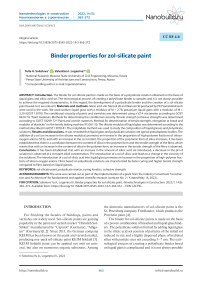Binder properties for zol-silicate paint
Автор: Yulia A. Sokolova, Valentina I. Loganina
Журнал: Nanotechnologies in Construction: A Scientific Internet-Journal @nanobuild-en
Рубрика: Construction materials science
Статья в выпуске: 5 Vol.14, 2022 года.
Бесплатный доступ
Introduction. The binder for sol-silicate paints is made on the basis of a polysilicate solution obtained on the basis of liquid glass and silicic acid sol. The technological process of creating a polysilicate binder is complex and it is not always possible to achieve the required characteristics. In this regard, the development of a polysilicate binder and the creation of a sol-silicate paint based on it are relevant. Materials and methods. Silicic acid sols Nanosil 20 and Nanosil 30 produced by PK Promsteklotsentr were used in the work. We used sodium liquid glass with a modulus of M = 2.78, potassium liquid glass with a modulus of M = 3.29 (GOST 13078). The conditional viscosity of paints and varnishes was determined using a VZ-4 viscometer according to GOST 8420-74. “Paint materials. Methods for determining the conditional viscosity. Tensile strength (cohesive strength) was determined according to GOST 18299-72* “Paint and varnish materials. Method for determination of tensile strength, elongation at break and modulus of elasticity” on the tensile testing machine IR 5057-50. The silicate modulus of liquid glass was determined according to the method described in GOST 13078-81. The molybdate method was used to study the composition of liquid glasses and polysilicate solutions. Results and discussions. It was revealed that liquid glass and polysilicate solution are typical pseudoplastic bodies. The addition of a sol (an increase in the silicate modulus) promotes an increase in the proportion of high-polymer fractions of siliconoxygen anions (SCA), and with an increase in the sol content, the proportion of the polymeric form of silica increases. It has been established that there is a correlation between the content of silica in the polymer form and the tensile strength of the films, which means that with an increase in the content of silica in the polymer form, an increase in the tensile strength of the films is observed. Conclusions. It has been established that with an increase in the amount of silicic acid sol introduced, a decrease in the pH of solutions is observed at a constant alkali concentration. The introduction of a sol of silicic acid leads to a change in the viscosity of the solutions. The introduction of a sol of silicic acid into liquid glass promotes an increase in the proportion of high-polymer fractions of silicon-oxygen anions. Films based on polysilicate solutions are characterized by faster curing and higher tensile strength compared to films based on liquid glasses.
Sol-silicate paint, polysilicate mortar, curing kinetics, cohesive strength
Короткий адрес: https://sciup.org/142235382
IDR: 142235382 | DOI: 10.15828/2075-8545-2022-14-5-363-372
Список литературы Binder properties for zol-silicate paint
- CAYMAN: Sol-silicate paint. Available from: http://www.alligator.spb.ru/catalog/materialy-tm-kayman/zolsilikatnaya-kraska-tm-kayman
- Histolith Sol-Silikat. Sol-silicate paint. Available from: http://www.caparol.ru/produkty/materialy-dljarestavracii-pamjatnikov-arkhitektury/histolith/histolith-silikatnaja-programma/histolith-sol-silikat
- KEIM Soldalit. Sol silicate facade paint for universal use. Available from: http://www.keim.com/ru-ru/produkcija/fasadnye-kraski/soldalit
- Prochnin. Sol silicate paint. Available from: http://www.fridlender.ru/products/solsilicate/zol-silikatnayakraska-prochnin
- Killman E. The stability of silica-aerosil-hydrosols under the influence of polymer adsorption. The effect of polymers on dispersion properties. J. Eisenlauer. Tadros.1989. Th. F. London: Academic Press; 1982.
- HDPE F 14. 1: 2: 4. 215-06 A technique for measuring the mass concentration of silicic acid (in terms of silicon) in drinking, surface and waste waters in a photometric method in the form of a yellow silica-molybdenum heteropolyacid. Center for Water Research and Control. SPb; 2006.
- Grasshoff, K. On the determination of silica in seawater. Deep-Sea Res. 1964; 11(4): 74–81.
- RD 52. 24. 433-2005. Mass concentration of silicon in surface waters of the land. MVI photometric method in the form of a yellow form of molybdosilicic acid. GU GUI; 2005.
- Loganina V.I., Kislitsyna S.N., Mazhitov Y.B. Structure and Properties of the Modified Binding for Silicate Paints. Materials Science Forum. 2018; 931: 469–474. Available from: https://doi.org/10.4028/www.scientific.net/MSF.931.469
- Rao I.V., Ruckenstein Е. Phase behavior of mixtures of sterically stabilized colloidal dispersions and free polymer. Journal of Colloid and Interface Science. 1985; 108(2): 389–402. Available from: https://doi.org/10.1016/0021-9797(85)90276-0
- Loganina V.I., Mazhitov Y.B. Estimation of Rheological Propertie of Sol Silicate Paint. Materials Science Forum. 2020; 992: 569–573. Available from: https://doi.org/10.4028/www.scientific.net/MSF.992.569
- Figovsky O., Borisov Yu., Beilin D. Nanostructured Binder for Acid-Resisting Building Materials. Scientific Israel–Technological Advantages. 2012; 14(1): 7–12. Available from: https://doi.org/10.17265/2159-5348/2017.03.003
- Kudryavtsev P.G., Figovsky O.L. Nanocomposite organomineral hybrid materials. Part 3. Nanotechnologies in Construction. 2016;8(3): 16–49. Available from: https://doi.org/10.15828/2075-8545-2016-8-3-16-49
- Ayler R. Silica Chemistry. Part 1. M.: Mir; 1982.
- Loganina V., Mazhitov Y., Skachkov Y. Assessment of the Structure of Polysilicate Binding with Added Glycerol. Materials Science Forum. 2020; 987: 15-19. Available from: https://doi.org/10.4028/www.scientific.net/MSF.987.15
- Figovsky O.L., Kudryavtsev P.G. Liquid glass and aqueous solutions of silicates as a promising basis for technological processes for obtaining new nanocomposite materials. Engineering Bulletin of the Don. 2014; 2.
- Salimian S., Zadhoush A. Water-glass based silica aerogel: unique nanostructured filler for epoxy nanocomposites. Journal of Porous Materials. 2019; 26(6): 1755 – 1765. Available from: https://doi.org/10.1007/s10934-019-00757-3
- Mazraeh-Shahi Z.T., Shoushtari A.M., Abdouss M., Bahramian A.R. Relationship analysis of processing parameters with micro and macro structure of silica aerogel dried at ambient pressure. Journal of Non-Crystalline Solids. 2013; 376: 30–37. Available from: https://doi.org/10.1016/j.jnoncrysol.2013.04.039
- Duan Y., Jana S.C., Reinsel A.M., Lama B., Espe M.P.. Surface modification and reinforcement of silica aerogels using polyhedral oligomeric silsesquioxanes. Langmuir. 2012; 28 (43): 15362–15371. Available from: https://doi.org/10.1021/la302945b
- Bartenev G.M., Zuev Yu.S. Strength and fracture of highly elastic materials. M., L.: Chemistry; 1964.


